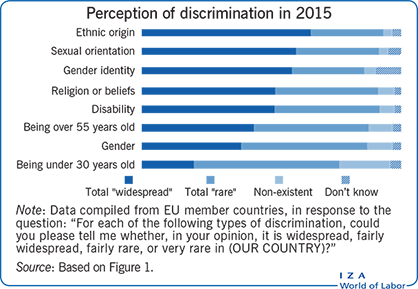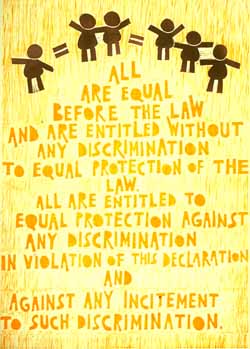Describe Ways Laws Have Been Used to Enforce Discrimination
One of the ways that OCR carries out its enforcement responsibilities is to investigate complaints that allege discrimination. It outlawed discrimination on the basis of race ethnicity religion sex or national origin by most employers and it created the Equal Employment Opportunity Commission EEOC to monitor employment discrimination claims and help enforce this provision of the law.

Iza World Of Labor Do Anti Discrimination Policies Work
Understand how civil rights have been used to extend more equality to groups that historically have been subject to discrimination.

. The Americans With Disabilities Act ADA of 1990. This is enforced by the Equal Employment Opportunity Commission EEOC. -Two centuries led to historic Supreme Court cases and congressional policies that seek to eliminate racism in the Constitutional aspect.
The Age Discrimination in Employment Act. However if the state has a law thats parallel to the federal law the claimant could have up to 300 days to file a charge of discrimination charge. States and institutions creating such laws face the difficult problem of balancing competing rights how to protect First Amendment.
These laws were intended against which racial minorities. Thus it has been used to strike down arguably race-neutral policies like zoning laws that make housing unaffordable for persons of color in a particular jurisdiction says Hutchinson. Although the final category is being disputed more on this later the EEOC currently interprets sex to include gender sexual orientation and gender identity.
Black codes and Jim Crow laws were laws passed at different periods in the southern United States to enforce racial segregation and curtail the power of black voters. Laws that prohibit discrimination based on race sexual orientation ethnicity and religion are sometimes challenged for limiting a persons or an organizations free speech rights rights of association or rights to freely exercise their religion. Oftentimes gender prejudice or discrimination is referred to as sexism.
There are a number of federal laws that seek to protect employees from potential discrimination in the workplace but there are three that stand out as particularly significant. For example prejudice and discrimination based on race is called racism. First of all a law against certain types of discrimination makes it abundantly clear that such discrimination is wrong and illegal.
The Age Discrimination in Employment Act of 1967 as amended protects individuals who are 40 years of age and older from employment discrimination based on age. The laws enforced by EEOC makes it unlawful for Federal agencies to discriminate against employees and job applicants on the bases of race color religion sex national origin disability or age. Under this Act it is unlawful to discriminate against a person because of hisher age with respect to any term condition or privilege of employment.
Discrimination can be based on many different characteristicsage gender weight ethnicity religion or even politics. Protects employees or future employees who are 40 or older from discrimination in the workplace. Prohibits sex-based wage discrimination between men and women who perform equal work in the same workplace.
A person who files a complaint or participates in an investigation of an EEO complaint or who opposes an employment practice made illegal under any of the laws that EEOC enforces is. Title VII of the Civil Rights Act of 1964 42 USC. Employment discrimination laws and regulations are enforced by the Equal Employment Opportunity Commission EEOC an agency established by the Civil Rights Act of 1964 Title VII.
There are often too few inspectors to find more than a small percentage of violators and not enough enforcement officers to deal with violators once they re found. It also prohibits employers from retaliating against an applicant or employee who. After the Civil War ended in 1865 some states passed black codes that severely limited the rights of black people many of whom had been enslaved.
The enforcing agency may not have adequate resources or personnel to enforce the laws At all levels - federal state and local - agencies are often underfunded and understaffed. In what ways have laws been used to enforce discrimination. It strictly prohibits all forms of discrimination on the basis of race color religion sex or national origin in all aspects of employment.
The Equal Pay Act of 1963 EPA which protects men and women who perform substantially equal work in the same establishment from sex-based wage discrimination. How OCR Enforces Civil Rights Discrimination Laws and Regulations. The provisions that affected private businesses and employers were legally justified not by the Fourteenth.
Title VII of the Civil Rights Act Title VII of 1964. So there is a good chance that an employer who always insisted on hiring good white boys between 25 and 30 looks at these laws and figures out just be themselves that they are doing something wrong and changes what they are doing. The Act has many anti-discrimination provisions including Title VIII of the Civil Rights Act of 1964 Equal Employment Opportunities which prohibits employment discrimination based on race color religion sex.
The Equal Pay Act of 1963 EPA. Title VII of the Civil Rights Act of 1964 Title VII which prohibits employment discrimination based on race color religion sex or national origin. Applicants or employees who believe theyve been discriminated against because of their race can file a charge of discrimination with the EEOC within 180 days of the alleged discrimination.
Finally OCR educates covered entities. The Equal Pay Act EPA of 1963. The most important law covering racial discrimination on the job is the Civil Rights Act of 1964specifically Title VII of that act.
Provide citations for all the sources you use. Discrimination is often the outcome of prejudice a pre-formed negative. Historical Worksheet Answer the following questions in 100 to 250 words each.
The Civil Rights Act was a very significant piece of legislation when it was enacted in 1964 and continues to protect individuals against discrimination. 2000e and following prohibits employers from discriminating against applicants and employees on the basis of race color religion sex and national origin including membership in a Native American tribe. Title VII of the Civil Rights Act.
OCR also conducts compliance reviews to determine if policies procedures and actions of covered entities are consistent with civil rights laws. Title VII is a powerful tool for combating discrimination and increasing diversity in law enforcement agencies. Title VII of the Civil Rights Act of 1964 makes it unlawful to discriminate in hiring discharge promotion referral and other facets of employment on the basis of color race religion sex or national origin.
Associate Program Material. Title VII prohibits employers including public sector employers from discriminating against individuals on the basis of race color national origin sex or religion. The Age Discrimination in Employment Act of 1967 ADEA.

Thematic Reports European Equality Law Network

Rights To Equality And Non Discrimination Australian Human Rights Commission

No comments for "Describe Ways Laws Have Been Used to Enforce Discrimination"
Post a Comment